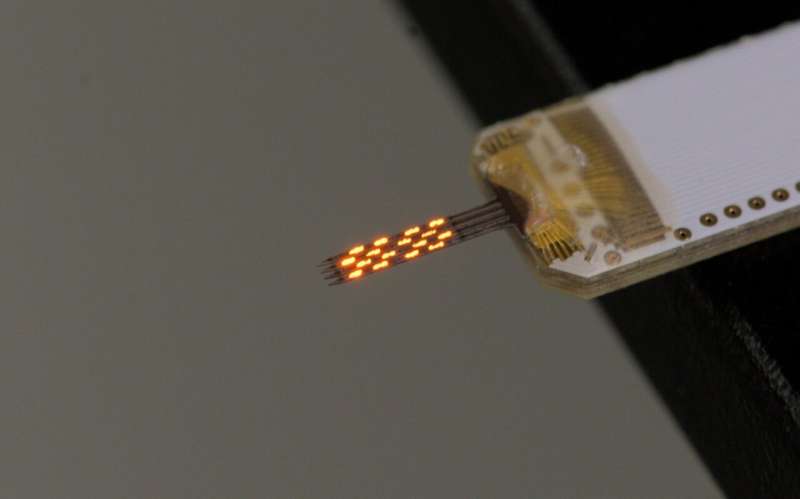September 27, 2023 feature
This article has been reviewed according to Science X's editorial process and policies. Editors have highlighted the following attributes while ensuring the content's credibility:
fact-checked
peer-reviewed publication
trusted source
proofread
Organic LED and CMOS-based optogenetic stimulation probes with single-neuron resolution

Optogenetics are advanced research tools that allow scientists to precisely control the activity of brain cells using light. Over the past few years, optogenetic techniques have become increasingly advanced, leading to exciting new discoveries about the brain and its intricate processes.
Researchers at Columbia University, University of Cologne and University of St Andrews have recently developed new probes for the optogenetic stimulation of neurons in the brain. Their devices, introduced in Nature Electronics, are remarkably precise and attain single-neuron resolution.
"Optogenetics requires the genetic modification of neurons and tremendous advances have been made on this front since the inception of optogenetics, rendering these modifications more targeted and more efficient," Malte Gather, one of the researchers who carried out the study, told Medical Xpress.
"The 'opto-' part of optogenetics (i.e., the delivery of light), by contrast remains either highly invasive (picture a literal window in the skull to project an elaborate pattern of light onto the brain) or relatively unspecific (i.e., light is delivered to a large region of the brain, rather than targeting individual clusters of cells, let alone single cells)."
Gather has been developing organic light-emitting diodes (OLEDs) for almost two decades. In his recent study, he set out to explore the possibility of applying these devices to the field of optogenetics, in collaboration with the team of Ken Shepard at Columbia University.
"I realized that OLED technology can offer something here that other technologies cannot," Gather explained.
"In a modern smart phone display, you have of order 1 million individual OLEDs, each of which can be switched on/off with high temporal precision to form a crisp image and display dynamic content. This ability is unique to OLEDs—conventional, inorganic LEDs require special substrates and so cannot be readily integrated on transistor backplanes that control the brightness in each individual pixel."
The primary objective of the recent work by Gather and his collaborators was to effectively shrink and re-shape the OLED displays commonly integrated in smartphones, ultimately attaining a compact and minimally invasive implant. This implant could then be used to manipulate the activity of individual neurons in an animal's brain using light.
"Our stimulation probes combine CMOS, the technology behind the majority of modern computer chips, with OLEDs, which form the light-emitting component in modern displays," Gather said.
"First, a CMOS chip that can drive 1,000 individual OLEDs was designed and processed to take the form of a shank, with four slender needles, each under 100um in diameter. The metallic contact pads on this chip were carefully processed to make them suitable for the deposition of OLEDs directly on top of the chip."
The researchers optimized both the color and brightness of the OLEDs they integrated in their optogenetic probe. They then directly deposited these OLEDs onto an integrated chip, using a vacuum deposition process.
On top of the OLEDs, they placed a robust but very thin film, which was under 15um in thickness. This protective layer ensures that the device continues to operate safely and reliably after it is implanted inside an animal's brain.
"For optogenetics to help unravel some of the greatest mysteries in neuroscience and for it to ultimately find use in the clinic, we need ways to control large numbers of neurons, with high spatiotemporal resolution and in a hugely parallel manner," Gather said.
"Using a technology that dominates today's smartphone displays, it is possible for the first time to scale the number of light sources on an implant into the thousands and potentially many millions, thus offering an innovative solution to this long-standing challenge."
In initial tests, the new optogenetic stimulation probes performed remarkably well, as they allowed the researchers to precisely activate individual neurons in brain regions as deep as 5mm. In the future, these promising devices could be used to carry out a wide range of genetic and neuroscientific experiments, potentially shedding some light on brain processes that are still poorly understood.
"This foundational work leads to many new opportunities, and we are actively working to explore several of these," Gather added. "One example exploits the fact that both OLED and CMOS technology scale very well. Rather than making implants one-by-one, we are interested to explore wafer-scale fabrication of devices, alongside making many significant further improvements to our technology."
More information: Adriaan J. Taal et al, Optogenetic stimulation probes with single-neuron resolution based on organic LEDs monolithically integrated on CMOS, Nature Electronics (2023). DOI: 10.1038/s41928-023-01013-y
© 2023 Science X Network



















